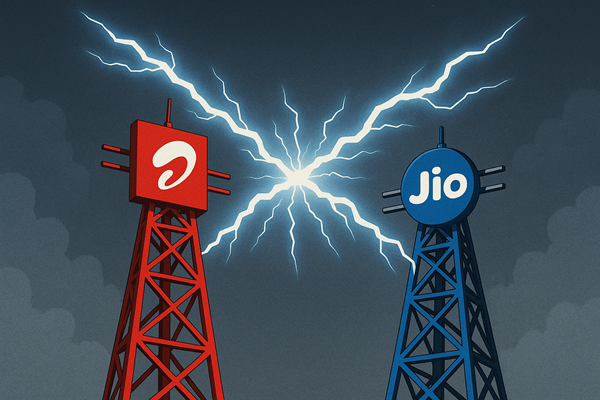.png)
June 11, 2025 at 2:11 PM IST
India’s telecom sector is buzzing with the news of Reliance Jio’s remarkable 5.6 million active subscriber addition in April 2025, especially in a month when the industry’s overall active base actually shrank by 1.5 million.
While this headline number has fuelled talk of Jio’s growing dominance, a closer look at the numbers reveals a more nuanced, two-speed market. Jio is winning the battle for subscribers, but Bharti Airtel is quietly taking the lead on revenue growth and profitability.
Jio’s subscriber momentum is clear. It was the only major operator to post a significant gain in active users in April, adding 5.6 million, while Bharti lost 4.1 million and Vodafone Idea lost 1.1 million. This allowed Jio to push its active subscriber market share up to 42.6%, gaining 60 basis points in just one month. Bharti’s share slipped to 35.9% and Vi’s to 16.2%. Jio’s gains were broadbased, with strong performance across all circle categories and especially in rural markets, where it added 1.2 million subscribers.
But the story changes when you shift the focus from subscriber counts to financial performance. The industry’s Adjusted Gross Revenue, a key measure of telecom revenue, grew 15.1% year-on-year in January-March, buoyed by tariff hikes that took effect in July 2024. Over the course of 2024-25, Bharti Airtel emerged as the biggest beneficiary of these hikes, with its AGR market share surging by 159 basis points, compared to Jio’s more modest 26 basis point gain.
By the March 2025 quarter, Bharti’s AGR stood at ₹277 billion, closing the gap with Jio’s ₹298 billion. Bharti’s incremental AGR for the year was also higher than Jio’s, highlighting its ability to extract more value from its user base even as it lost some subscribers.
This divergence is rooted in strategy. Jio is all about scale, rural expansion, and aggressive pricing, which has helped it capture market share and boost its reported subscriber base for 28 consecutive months. Its Visitor Location Register, or active user, ratio improved to 96.6% in April, reflecting better engagement, but still trails Bharti’s 98.9%. Jio’s aggressive push into 5G fixed wireless access is also paying off, with the company holding an 81.9% market share in this fast-growing segment, dwarfing Bharti’s 18.1%.
Bharti, meanwhile, has focused on premiumisation and operational efficiency. Its average revenue per user remains significantly higher than Jio’s, and its revenue growth in metros and C-circles has been particularly strong, with 20% quarter-on-quarter growth in the former. Bharti’s leadership in the machine-to-machine segment and its diversified portfolio, including enterprise and Africa operations, are also helping it weather the churn in active subscribers.
Despite losing 4.1 million active users in April, Bharti’s ability to grow revenue and maintain high engagement levels demonstrates the power of a quality-over-quantity approach.
Vodafone Idea, on the other hand, continues to struggle. The company lost 1.1 million active users in April, marking its 17th consecutive month of subscriber declines. Its AGR market share dipped to 13.4%, and its VLR ratio remains the lowest among major players at 85.1%.
Without a credible turnaround or government intervention, Vi’s long-term viability remains in question, raising the spectre of a market increasingly dominated by just two players.
Jio’s scale and rural reach are impressive, but Bharti’s ability to translate a smaller, more engaged base into higher revenue growth and market share gains is a reminder that profitability and pricing power matter just as much as raw user numbers. The sector’s future will depend on whether Jio can convert its subscriber surge into sustained revenue growth, and whether Bharti can continue to monetise its premium user base while stabilising churn.
While the telecom sector looks like a contest between scale and quality, both Jio and Bharti are showing there’s more than one way to win.





